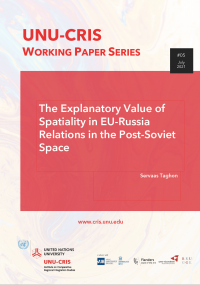The Explanatory Value of Spatiality in EU-Russia Relations in the Post-Soviet Space

EU-Russia relations within the context of the post-Soviet space have been one of the most investigated research topics in the field of international relations. With the return of great power politics, this region has been one of the centres of attention for researchers of geopolitics. However, while geography and borders have played prominent roles in this debate, the aspect of spatiality has barely been researched. This paper seeks to explore these concepts in the post-soviet space. Rather than viewing this region as a static and defined space, we look at how it is approached to be integrated within the structures of the European Union (EU) and Russia. Moreover, this paper challenges the fixation on hard power and soft power within the EU-Russia debate. Through the application of spatial concepts and their link with power, we aim at bringing new insights to the debate about the post-soviet space. Specifically, we apply spatial concepts to the EU’s European Neighbourhood Policy (ENP). After that, we compare these instruments and their objectives with the Russian approach and look at how they differ or resemble EU-policies and intentions. We find that rather than the product of hard power and soft power, post-soviet countries are actively integrated within the wider spatial strategies of Russia and the EU. Through our analysis we discovered spatial concepts to be more appropriate and comprehensive to understand the conflict between Russia and the EU in the post-soviet space. In fact, instead of clashing perceptions in foreign policy attitudes, the conflict exposes deeper rooted and conflicting notions of space. While Russia views the post-soviet space as an indispensable part of itself, the EU aims at extending the EU community beyond its natural borders to create a common space of values.
